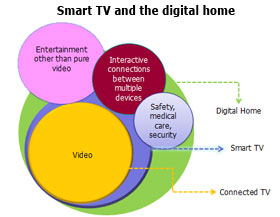
Smart TV is a new and evolving television environment that makes use of the openness and interactivity of the Internet. Many of the features of traditional TV, such as one-way signal transmission, closed platform architecture, the privatization (cable and satellite TV operators build their own transmission networks) or franchising (terrestrial TV stations are granted usage rights to specific frequencies) of transmission networks, and business models where operators act as bridges between content and viewers, are all set to face unprecedented challenges as Internet and TV services are more closely integrated.
While "Internet TV" refers to the changeover from traditional broadcasting to the use of the Internet to transmit video, smart TV instead emphasizes the greater value that the openness and interactivity of the Internet brings to viewers. Besides more flexible viewing services and richer content, smart TV can also provide non-video entertainment services such as sophisticated games or participation in TV show voting activities. Even more importantly, smart TV can be used for purposes that go beyond pure entertainment, such as video calling, gaming and even home security and medical care.
However, the feasibility of these potential applications for smart TV rests on the integration of smart TV platforms with IC technology solutions. Any company that is able to secure a key position in commercial models for smart TV, or even to lead the development of such commercial models, could potentially become the dominant power in the next television revolution as smart TV gradually replaces traditional television.
Chart 2: Scope of connected TV, Internet TV and smart TV industries
Chart 5: Samsung plans to offer Comcast and TWC TV Everywhere services
Chart 7: Comparison of LG's NetCast platform (2010) and smart TV platform (2011)
Chart 8: Panasonic Viera Connect health and fitness applications
Table 1: Specification comparison of the 2006 and 2010 Apple TV
Chart 15: AirPlay expands Apple TV's range of content using content from other iOS devices
Chart 21: Yahoo main strategies for its push back into connected TV
Chart 22: Samsung and Toshiba's new TV models for 2011 feature a Yahoo shortcut button
Chart 23: Yahoo Connected TV business model integrates broadcasting with the Internet
Chart 25: Strategic analysis of the Xbox 360's entry into the TV market
Chart 26: Xbox 360 brings in TV services in several different ways
Chart 27: Key elements of the Videoscape digital home solution
Chart 28: Videoscape search results brings together broadcast, OTT and personal network content
Chart 29: Videoscape brings together OTT content, picture quality and a workable business model
SoC design challenges resulting from the open Internet environment
Chart 36: Trends in the specifications of smart TV DTV SoCs and connectivity IC solutions
British terrestrial broadcasters moved into on demand services at a very early stage
Chart 40: Phases of development for connected TV models in the China TV market
Legality of connected TV affirmed by establishment of license system
Chart 41: Partnerships between connected TV integrated service license holders and TV vendors
Manufacturers are switching to smart TV in 2011 to circumvent regulation by SARFT
Chart 42: China-based TV vendors have rushed to announce smart TV models in 2011
Major TV vendors are pushing connected TV services, while acTVila has become the largest platform
Chart 43: Types and sources of acTVila video content available in Japan
Chart 45: Survey on the use of online video services for TVs in Japan

